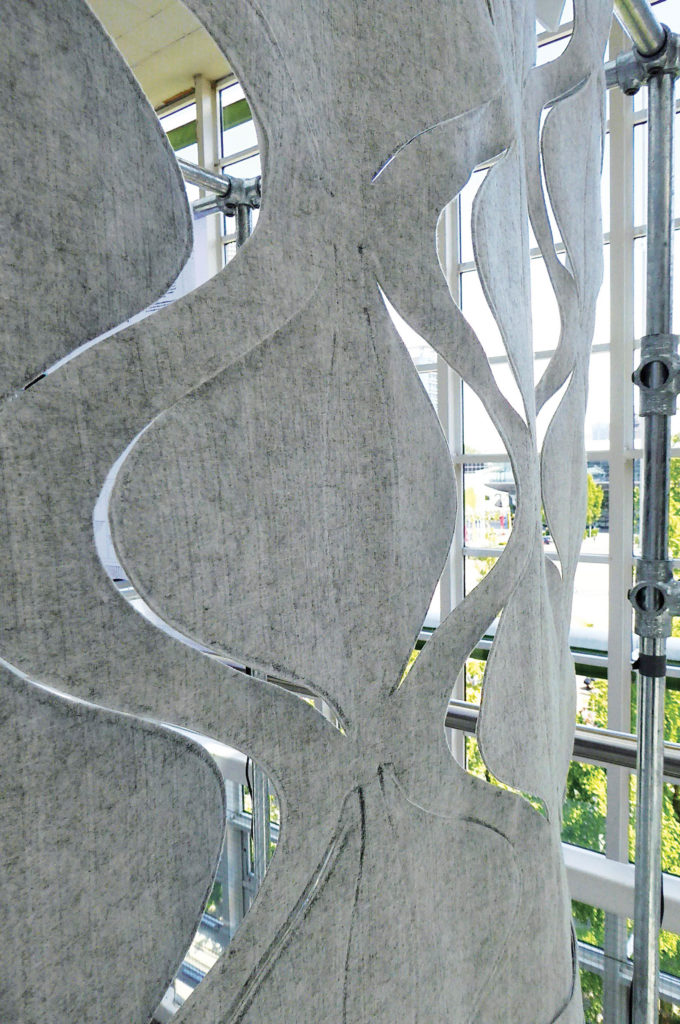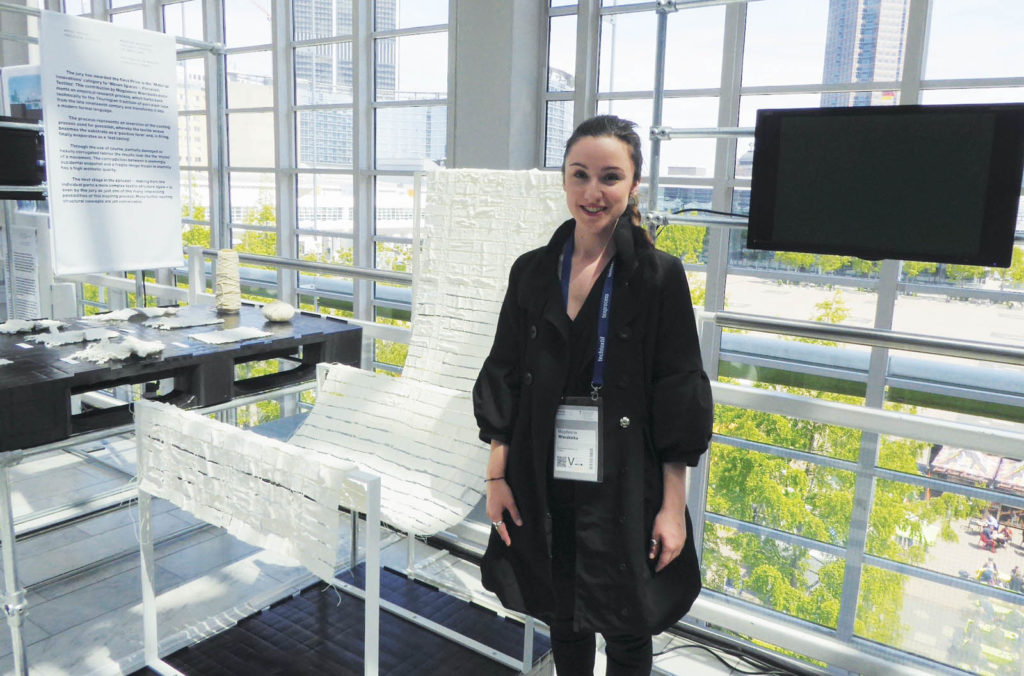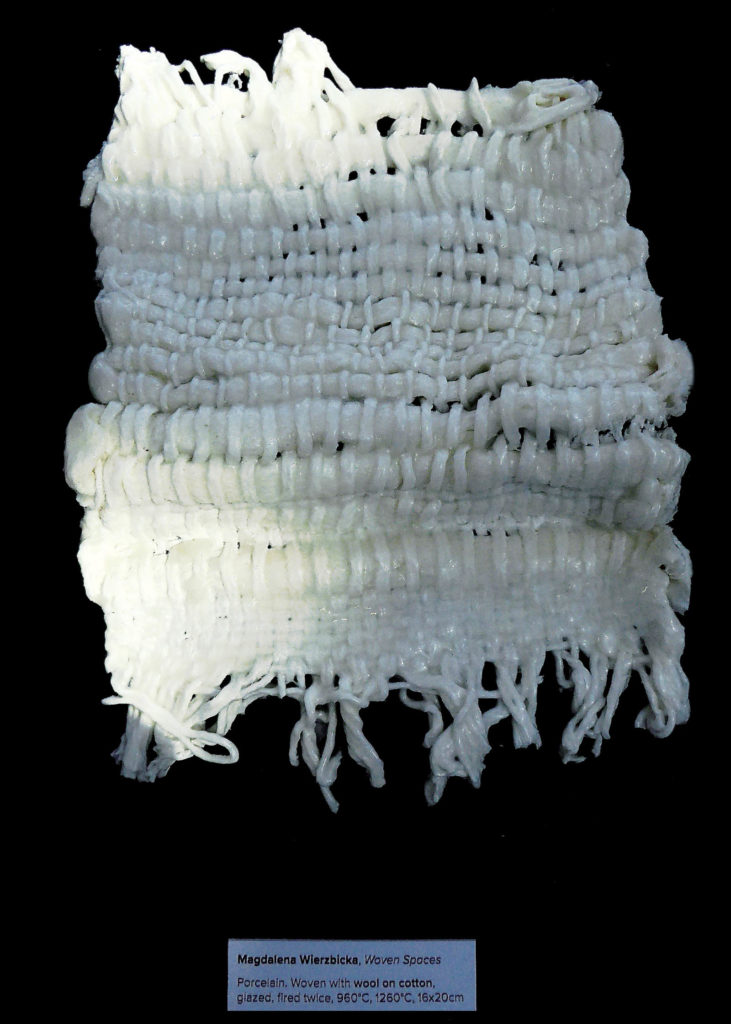A student competition for textile structures highlights the Techtextil show—and presages new building technologies.
by Marie O’Mahony
The Techtextil student competition is now in its fifteenth year, sponsored by Brussels-based TensiNet, which has provided €8,000 in prize money for the winning submissions. In his opening remarks at the show, Professor Stefan Schäfer, chair of the competition jury, stressed the importance of student competitions for engineering students in gaining experience with alternative technical approaches, where complex requirements cannot be met by a single discipline. This year’s theme: “Textile Structures for New Building 2019.”

First prize in the Micro Architecture category was awarded to the biomimicry-inspired “Airdapt,” a hydro-actuate mechanism to open and close a section of a modular wall, designed and prototype built by Rebecca Schedler at Weißensee Kunsthochschule, Berlin, Germany. Inspired by the Venus flytrap plant, with the hydro-actuation opening mechanism looking to the principles around Ice Plant seeds, the kinetic wall combines two biological mechanisms: an elliptical shaping of individual actuators and the swelling of these elements by air pressure, through incremental changes in the volume and stretching of the material. The length and width are both shortened to provide traction and movement as the cut-out wings in the design are lifted, allowing air and light to pass through and creating a greater connection between the adjoining spaces. In the prototype, two layers of polyethylene film and one of polyester felt are combined, with the thickness and density of the materials based on the degree of acoustic performance required. Occupants can transform their environment at the touch of a button—literally.
Urban explorations
Two other winning projects deal with former industrial and human activities on the respective sites, one focused on preservation and the other on urban renewal.
From Thammasat University in Thailand, Thitiwut Pakdee, Surakist Hunpaisarn and Chonticha Wimonchailerk took second prize in the Macro Architecture category with their design of a membrane shelter at Ayutthaya, on the premises of a former shipyard at the convergence of two rivers, the Chao Phraya and Pasak. The old town is a World Heritage Site, and the shipyard itself is a living museum. The design uses a membrane roof to offer protection against sun, wind and rain; the design was inspired by the sails and waves of classic shipbuilding, with sails of different sizes arranged in a simple modular fashion. Each assembly is made from two parts: a large six-point sail with a hanging loop for load transfer, and a small four-point sail with the classic simple surface. The use of an additional sail assembly was also proposed to increase shade coverage.
In the northern hemisphere, with very different criteria, Galen Rochon, a researcher in the School of Architecture at Dalhousie University, Canada, received a commendation for his project “A Catalyst for Urban Renewal.” The Prince of Wales Bridge in Ottawa, Ontario, Canada, has spent the last 20 years as an unused industrial monument—a steel framework bridge with 13 sections, all but one of exactly the same dimensions. Rochon’s project looks at how to fill this “empty” urban space, offering pedestrians a more positive experience, and by extension, leading to greater use of the structure. A series of double-curved membranes is proposed, attached at various points to the existing bridge structure. Different viewpoints are hidden and revealed as a visitor moves through the structure, creating a fresh vision and experience for the public.

Form, shape and texture
In an exploration of materiality, Magdalena Wierzbicka, from the Piet Zwart Institute of The Netherlands, was awarded first prize in the Material Innovations category. Wierzbicka was inspired by the Thuringian porcelain lace of the late nineteenth century. Thuringian figurines were often of the sweet “chocolate box variety,” depicting ladies swathed in layers of lace and crinoline skirts, with lace and netting dipped in porcelain to achieve the desired effect. Scaled to architecture proportions, the full-length hanging uses a woven textile to give the porcelain form, but it is then lost in the firing in a “lost-casting” process. What remains is the shape of the textile, its curved edges and weave texture. When installed, the gentle sound of the ceramic tinkling can be heard, with a unique quality of light.
Throughout the presentations at Techtextil, academic researchers showcased their most recent projects, responding to real industry problems and always realizing potential environmental impacts. Practical considerations, rather than creating barriers, merely served to ground these projects and make their innovations all the more plausible to be commercialized in the future.

Environmental economics
With all the attention now being given to creating digital microfactories, researchers at the RWTH Aachen University Institute of Textile Technology (ITA) are looking at ways of manufacturing in extraterrestrial environments—using locally sourced raw materials. The venture makes economic as well as environmental sense, because transporting even a single kilogram of material by rocket or space shuttle costs an estimated €10,000. Thilo Becker, Alexander Lüking and the team at ITA are proposing that the solution is to work with what is already there—moonstone—turning it into a fiber and then into cloth.
There are many challenges, not least the lack of gas, oil or power outlets on the moon. On Earth, working with volcanic basalt can be used as a close approximation. The rock is broken into finger-size pieces and poured through a funnel into a high-performance furnace, where it is melted at temperatures of more than 1,100 degrees (C). It’s then merged through a platinum nozzle to be spun into very fine flexible fibers.
Environmental issues are also a strong focus of research at the Swedish School of Textiles in the University of Boras. Researchers have been working to address waste forestry products for a number of years, and Coordinator Lena-Marie Jensen was showing the latest initiatives at TechTextil. Longevity of product is a recurring question around the use of paper in garments and interiors, so the team’s new development is water-resistant. For interiors, the paper can be used for screens, sofas and chairs; it can also be used in garments with good drape and handle. Surprisingly, however, recycling is an issue because of the waterproofing, and there are concerns about the long-term financial viability of such a facility that must be linked to regular and high-quantity supply.
The European universities that I spoke with at Techtextil estimate that 70–90 percent of their research projects are industry-related. There is a mutual commitment between research and industry, and the benefits to each are increasingly evident. An important outcome of this is the positioning of academic research right from the outset to plan for scale to production and commercialization. The phrase “it’s academic” is starting to have new meaning for the textiles industry.
Marie O’Mahony is an industry consultant, author and academic, and visiting professor at the Royal College of Art (RCA), London. She is the author of several books on advanced and smart textiles published by Thames and Hudson. www.linkedin.com/in/marie-o-mahony-94776836
 TEXTILES.ORG
TEXTILES.ORG


